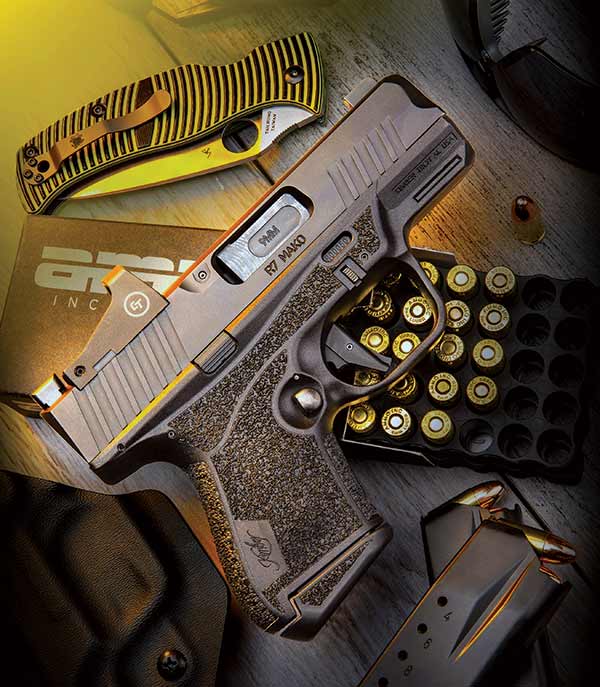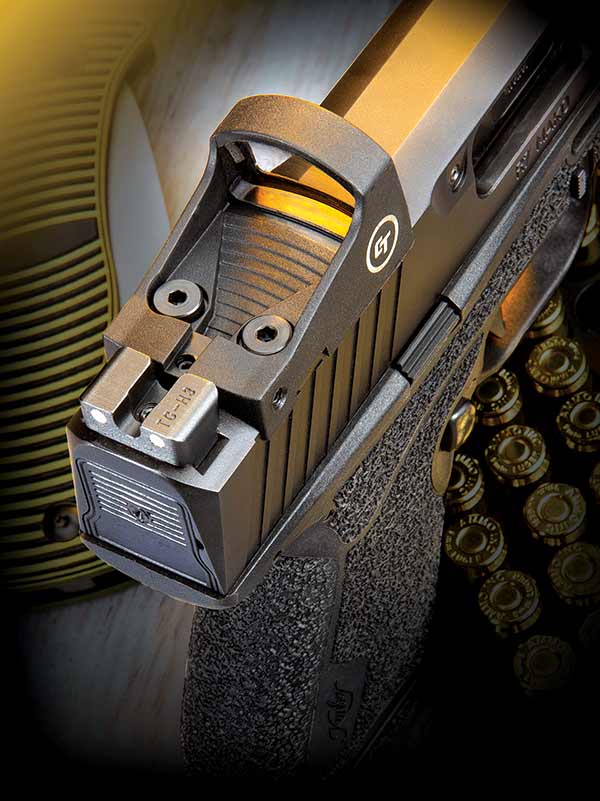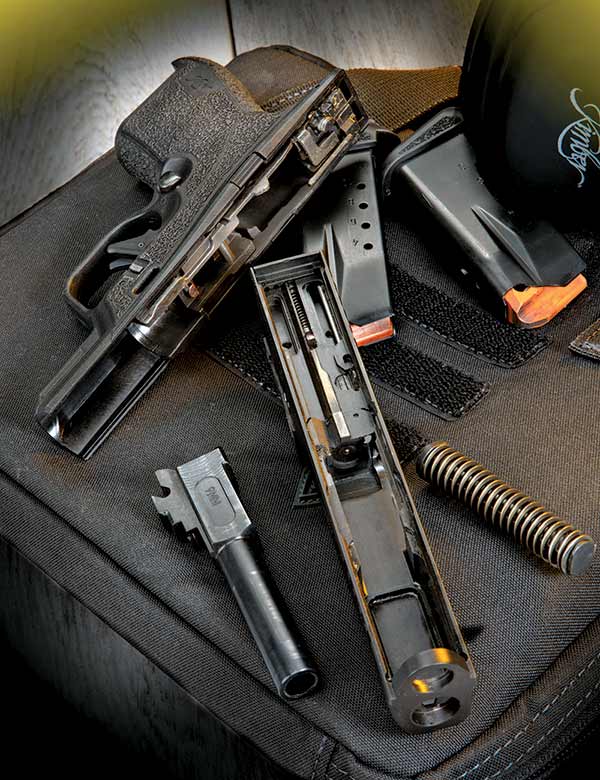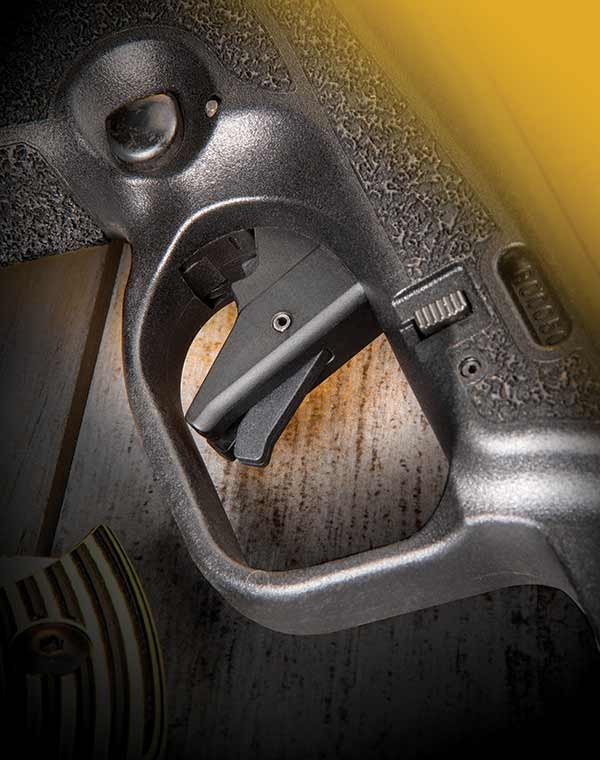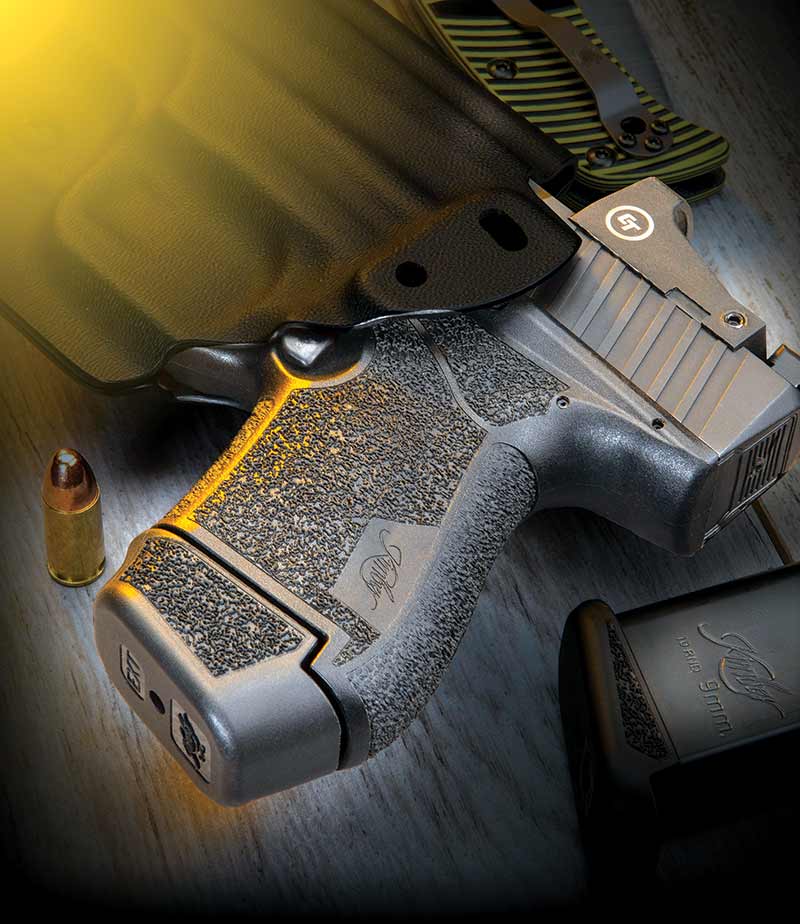Kimber’s R7 Mako Compact
Optics-Ready Pistol
Kimber’s reputation is built on refinement more than invention. They didn’t invent the 1911, but their groundbreaking incorporation of custom features on factory pistols set the tone for the entire industry. Nor did they invent the bolt gun, but Kimber’s Caprivi express rifle, again incorporating custom design features, is an exceedingly well-made rifle that’s hard to equal at the price.
So it is with the R7 Mako, Kimber’s recently introduced polymer frame, striker-fired micro 9mm. The alert eye will recognize features from a certain Austrian pistol, such as the blade-type “safety” protruding from the trigger, as well as aftermarket touches like its flat face and the fine, grippy texturing molded into virtually the entire frame surface. Stippling during manufacturing saves the cost of adding it later and reduces the risk that an excess of enthusiasm or deficit of soldering iron prowess will melt through something important.
The smooth magazine catch is ambidextrous, as is the slide stop, which is flush with a sleek ridge rising from the sides of the frame to protect it from inadvertent activation. Magazine capacity is either 11 or 13 rounds of 9mm, though the early sample I was sent came with four 10-rounders, two with extended baseplates. Weight unloaded is a svelte 1 lb., 7 oz., and the upward angle on the bottom of the magazine pad gives the matte black gun a rakish look reminiscent of the Devel Socius custom pistols.
Carry Optic Modifications
Carry optics are the current thing, and the Mako was designed for one from the ground up. The slide either comes with the mounting cut (OR) or with a Crimson Trace CTS-1500 series optic already installed (OI). Kimber also located the ejection port entirely on the side of the slide, which strengthens it and cuts down on the burned powder, etc., flung back at the front lens of the optic. Remember, there are reasons some IPSC open guns come with blast shields. It also reduces the chances of an empty case ejecting into the lens and cracking it, something appreciated by all of us who have been centered in the forehead by hot brass before. While it’s fair to ask if the smaller port could cause reliability problems, it did not in the 500+ rounds I fired.
Little guns carry easier but are hard to shoot well due to grip size, recoil and the short sight radius. The combination of texture and a mild palm swell kept the Mako locked solidly in my hand, and the high undercut triggerguard keeps the axis of the bore low relative to your hand, which reduces felt recoil. At no time was it uncomfortable to shoot, even though I fired nothing but defensive ammo through it, much of it +P.
Sight Science
On a short gun, the nearness of the front sight to the rear minimizes your eye’s ability to pick up on misalignment. If the barrel is twice as long, it’s twice as obvious and easier to correct. This is why some target pistols have a front sight sticking out well beyond the muzzle, and why longer barreled pistols are perceived as more accurate. Some are, but the human element is the bigger factor. Here’s where the optic makes things interesting.
By replacing two aiming coordinates with a single one, the only alignment required is between dot and target, rather than front, rear and target, which eliminates the sight alignment problem with short pistols. It also means your eye only has to focus on a single plane — the target — instead of three, which is not only faster but means you can see better what the target is doing and how it responds. This is a characteristic shared by the laser and it’s particularly valuable for a self-defense pistol.
But that’s not the end of the story: mechanical and electrical devices fail. While optics have proven themselves on rifles (some more so than others) they are not mounted to the rifle’s bolt and getting slammed back-and-forth at whatever X-hundred feet per second it is moving. I’m not throwing shade on the Crimson Trace optic on the Mako: It performed flawlessly, but we need to acknowledge the nature of the physics an optic has to overcome, and this includes having a backup plan if it fails. Wisely, Kimber included high-profile tritium sights from TruGlo that co-witness through the optic and use the same rear dovetail as GLOCK sights, which lets the Mako access its large aftermarket selection of sights.
The sighting channel in the base of the optic is a little narrower than the U-shaped notch and is visible in the bottom of the sight picture, something I noticed while handling the gun but not while shooting it. The front sight has a tritium dot surrounded by an orange-ish ring intended to make it higher visibility, while the rear has two dots. Having twice the tritium on the rear sight draws your eye to it, and not to the front sight, which is a universal problem for all three-dot night sights. While some makers address this by using a larger (and therefore brighter) dot up front, the Mako’s front dot is somewhat smaller and dimmer than those on the rear, particularly when viewed through the optic. I understand they are a backup system, but if you need them, you will need them fast and a brighter front relative to the rear is quicker to acquire.
Tilting Barrel Tweaks
A subdued mounting rail is molded into the frame dustcover and Kimber is currently working with industry partners to develop accessories that will mount to it. Intriguing from a mechanical viewpoint is the Mako’s breechface is pinned into the slide rather than machined as an integral part. It’s been done before, but not often, and on the Mako it may be done to accommodate the rear locking lug on the barrel.
The vast majority of centerfire semi-auto pistols use the Browning-style tilting barrel arrangement where the barrel is locked to the slide at the time of firing, and then pivots downwards at the rear, unlocking as the slide moves backwards. This adds weight to the slide to keep the breech closed at the moment of firing, then frees the slide to move by itself during the feeding cycle after chamber pressure has dropped to a safe level. John Browning originally used concentric rings located on the barrel forward of the chamber to mate with similar rings inside the slide to lock the two together, as is found on the M1911 and Browning Hi-Power. Most later designs use the chamber area of the barrel as the locking lug, with the front face of the chamber mating with the ejection port. By moving the locking lug to the rear of the chamber instead of the front, Kimber has reduced the angle at which the barrel unlocks in an attempt to reduce felt recoil. Clever and simple, as most good designs are.
It’s also worth noticing the steel chassis of the gun — frame rails, etc. — also appears to be pinned into place in the polymer grip frame. While there was no definitive answer from Kimber, it makes me wonder if we’ll see other interchangeable grip frame modules, a la SIG’s 320. At this point, it’s pure speculation on my part, but we’ll see.
Trigger
The flat face of the trigger, de rigueur these days, made it virtually impossible to get consistent readings from my Lyman trigger gauge, as the movement of the gauge’s roller changed the amount of pressure required to break the trigger. I managed to get an average of just over 5 lbs. with one set of readings, but in practice, it feels significantly lighter, which is one of the marks of a good trigger. As with most pivoting triggers, whether you feel any creep depends largely on where you place your finger, but there is very little and I rarely noticed it while shooting — again, likely a function of finger placement. The minor roughness I felt at first quickly smoothed itself out while shooting, leaving the pull feeling smooth and light. Reset, while less pronounced than my GLOCK 19, is still distinct, with a crisper click than my M&P. If you want a Kimber trigger with zero creep at all, you should look at their 1911s. But for a striker-fired trigger, the Mako’s is excellent. My only criticism is it sometimes pinches my finger between the trigger and its slot in the frame, which would benefit from a slight bevel.
Shooting Impressions
The Mako consumed 560 rounds of 9mm defensive loads from Black Hills, including their HoneyBadger in 100- and 125-grain weights, as well as both standard and +P 115-grain jacketed hollowpoints. Reliability was very good, with a single failure to feed (round #52, a +P JHP), and one failure to lock the slide back at round #130. As is my custom when testing, I neither cleaned nor oiled the pistol at any time.
Like any short dual column mag, the stubby little magazines could be challenging to angle correctly during speed reloads. On several occasions, the slide dropped when I slammed the new mag home, but that may be a function of how firmly I seat magazines. On every occasion, though, it properly loaded the top round as it fell.
Hidden Handling Benefits
This brings us to one of the other great revelations about red dots, — their location on the slide makes traditional slide manipulations difficult. Shortly prior to receiving the Mako, I received some instruction on red dots from Gunsite instructors Lew Gosnell and Aimee Grant and learned the correct way to drop the slide after a reload.
We all know the debate about using the slidestop during a reload or grasping the slide with your support hand to pull it back and drop it. From a combatives perspective, I prefer the gross motor skill of grasping the slide, which is less affected by stress than the fine motor skill of trying to find the slidestop with the tip of your thumb.
Using the optic takes it one step further: Just bring your palm back towards your chest like you were fanning a single action revolver and whack the optic with the heel of your hand. When you hit it, the slide falls. It is lightning fast, and if it’s possible to leave enough of a handprint on the optic to blur the sight picture, I didn’t manage to.
I’ve shot various optic-equipped handguns off-and-on for over 20 years now, but I was agnostic about their use on carry guns. The difference the Crimson Trace makes for the Mako, however, is convincing. The auto-brightness-adjusting 3 MOA dot worked whether it was bright or rainy, and in my limited time I never approached the expected 5,000+ hour battery life.
I’d say the gun was stupid accurate, but there’s nothing stupid about hitting your target, so it needs another superlative. Either “superb” or “shocking” would do. Handheld, I put five rounds into less than 3″ at 25 yards from an unsupported standing position. This was typical performance for the Mako — it also performed acceptably at 100 yards — but far better than I expect from a compact pistol. The combination of good ergonomics and trigger with excellent mechanical accuracy makes it easy to shoot well, and the red dots’ simplification of the sighting process removes the traditional drawback of having a barrel that’s a mere 3″-and-change long. The combination makes a formidable package for concealed carry where accuracy, speed and dead reliability are critical.
No wonder they named it after a shark.
For more info:
KimberAmerica.com
Black-Hills.com
CrimsonTrace.com


